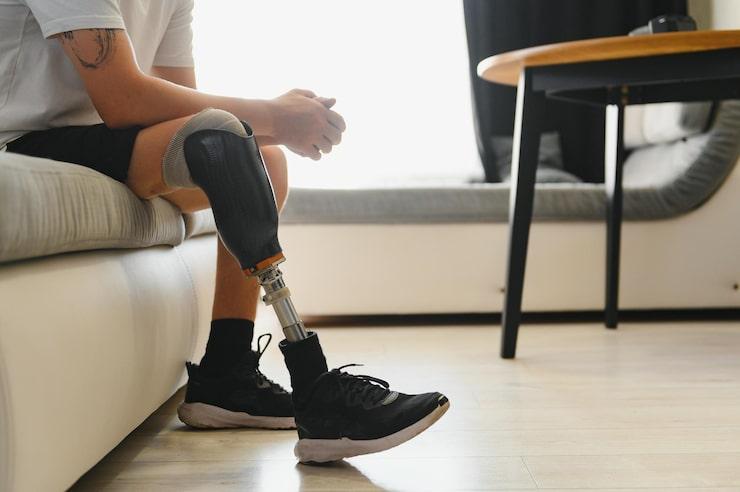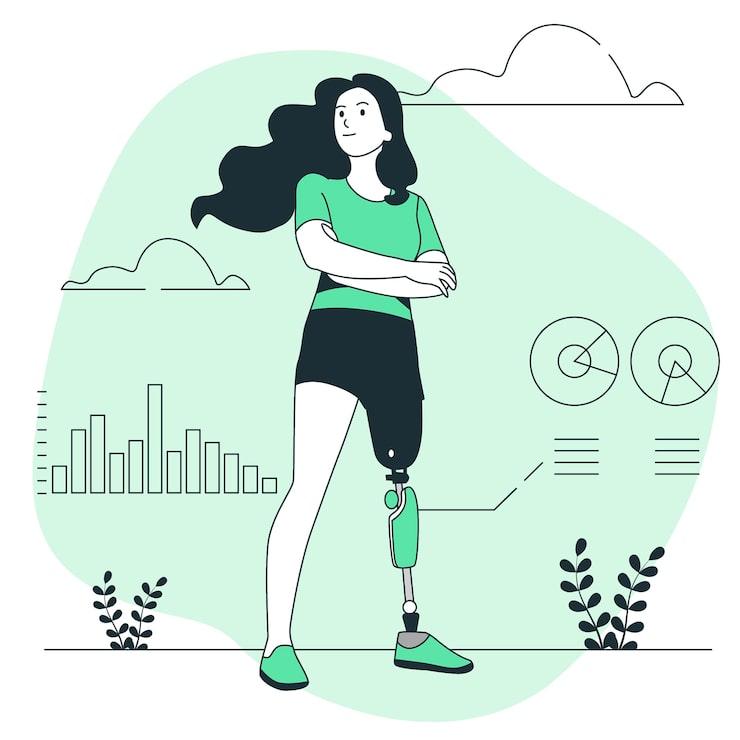
a person with a prosthetic limb post amputation
The thought of amputation may be very scary for patients and their families. Losing a limb is not just a physical change; it is also a mental and emotional challenge. But because of advances in modern medicine, surgery, and prosthetic technology, many people can now live alone and happily after losing a limb.
This blog provides comprehensive information about amputations, including what they are, why they occur, the healing process, and how hospitals assist individuals in regaining mobility and confidence.
Amputation is a type of surgery that removes a limb or part of a limb, such as an arm, leg, hand, foot, finger, or toe. It is usually done to stop the spread of disease, infection, or serious injury that can't be treated in any other way.
Amputation can be either full (removing the whole limb) or partial (removing part of a limb). Amputations are grouped by where they take place, like :
Amputations are only performed when all other treatments, such as medication, surgery, or wound care, have not been effective in restoring healthy circulation or function. Some reasons are:
1. A serious injury or trauma
Injuries from work, car accidents, or war can all hurt bones, muscles, and blood vessels in ways that can't be fixed.
If a limb is too hurt to heal or is at risk of infection, amputation may be the safest thing to do.
2. Peripheral artery disease (PAD) makes it hard for blood to move around in your body.
Diabetes and peripheral vascular disease (PVD) are two examples of diseases that can slow blood flow to the limbs and cause tissue death (gangrene).
In extreme cases, amputation may be necessary to stop the infection from spreading.
3. Bad Infection
Infections that last a long time or go untreated can hurt tissue in a way that can't be fixed, especially in people with diabetes.
Gangrene is when tissue dies because it doesn't get enough blood. It usually needs to be cut off right away.
4. Cancerous Tumors
Amputation may be necessary for bone or soft tissue cancers (like sarcomas) if the tumor can't be completely removed without it.
5. Burns or frostbite
In some cases, amputation may be necessary for severe frostbite or burns that destroy tissue.
6. Conditions that were there from birth
Some babies are born with limb problems that make it hard for them to move or do things later in life.

doctor and patient discussing test results prior to the amputation
Before the surgery, the medical team carefully checks everything to ensure the patient's safety and that the surgery will proceed as smoothly as possible. This could mean:
1. Anesthesia
The patient is either asleep (general anesthesia) or numb from the waist down (spinal anesthesia) during the surgery.
2. Getting rid of the tissue that is damaged
The surgeon removes the diseased or damaged tissue and shapes the remaining limb, known as the residual limb or stump, so that it fits comfortably into a prosthetic device later.
3. Putting on clothes and sewing
To help the wound heal, it is carefully closed, and a sterile dressing or compression bandage is applied to reduce swelling.
The length and difficulty of the surgery depend on the location of the amputation and the reason for the procedure.
Recovery from amputation has three parts: physical, emotional, and functional.
1. Getting care and staying in the hospital right after surgery
Most patients stay in the hospital for a few days after surgery. Pain is managed with medication during this time.
Changing dressings frequently helps prevent infections from occurring.
The area where the surgery was performed is checked to ensure it is healing well.
Doctors may also recommend light exercises to help you stay strong and prevent stiffness.
2. Healing wounds and getting back to your normal level of activity
Physical therapy plays a crucial role in the healing process as the wound begins to heal. Rehabilitation is all about strengthening the muscles in the body and the remaining limb.
Improving your balance and posture.
Teaching people how to use crutches, wheelchairs, and other assistive devices to move around.
3. Putting on a fake limb
After the wound has healed and the swelling has gone down, you can get a prosthetic limb.
A prosthetist ensures that the device fits well and functions as intended.
Patients learn how to use and care for the prosthesis and practice walking.
4. Improving your mental and emotional health
Life can be hard after an amputation. It's normal to be sad, mad, or depressed.
Many hospitals offer counseling and support groups to help patients and their families cope with their challenges and regain a sense of well-being.
Modern surgical techniques work very well, but there are some risks you should know about:

an illustration of a happy person post amputation
After an amputation, life isn't over. It's a new beginning with new goals and problems to solve. With the right medical care and determination, most people can get their freedom back and live happy lives.
1. Freedom in terms of physical health
You can move again once you learn how to use prosthetics or mobility aids.
Rehabilitation teaches you how to move safely, take care of yourself, and do things you do every day.
2. How Strong Your Emotions Are
Family counseling and support are very important for getting over emotional pain.
Many amputees stay motivated by community programs and support groups for fellow amputees.
3. Ongoing medical care
Surgeons and physiotherapists regularly check the prosthetic and the healthy limb to ensure they fit well.
4. A healthy way of life. Eating well, staying clean, and not smoking or drinking too much alcohol are all good for your health and help you heal.
Prosthetic limbs have undergone significant changes since their inception. Bionic and computerized prosthetics can move like real arms and legs and even respond to signals from muscles. Because they are made of lightweight materials, feature advanced joints, and can be customized to fit your needs, they are more comfortable and versatile.
Hospitals and rehabilitation centers now collaborate with advanced prosthetic manufacturers to help patients move more easily and lead better lives.
1. How long does it take to get better after an amputation?
The patient's health, the type of amputation, and how well they are doing in rehab all play a role in how long it takes to heal. It can take the body 4 to 8 weeks to heal, and the mind even longer to get used to things.
2. Can everyone get a prosthetic limb?
Most patients can, but this depends on their overall health and the condition of their remaining limb. Your doctor and prosthetist will decide if it's the right choice for you.
3. Is pain in a phantom limb real?
Yes. Many people who have lost a limb can still feel things in that limb. Nerve signals cause it, and you can treat it with drugs, therapy, or nerve stimulation.
4. Is it possible for me to go back to work or play sports after having my leg cut off?
Yes, of course. With the right prosthetic and therapy, a lot of amputees can go back to their old jobs, play sports, or even start new ones.
5. What can family members do to help someone who has lost a limb?
Be there for them emotionally, help them with everyday tasks while they heal, and go to therapy sessions when you can.
Amputation can significantly change a person's life, but with the right medical care, rehabilitation, and emotional support, alongside the necessary courage, they can adapt, heal, and thrive. Hospitals play a crucial role in ensuring that surgery is safe, that patients receive high-quality care after surgery, and that prosthetic rehabilitation is advanced.
An amputation does not define an individual's capabilities or future, irrespective of whether it resulted from an injury, illness, or other unfortunate circumstances. With determination, medical help, and support, life after amputation can be full, active, and empowering even in the most devastating situations.
We offer expert care across key specialties, including Medicine, Cardiology, Orthopaedics, ENT, Gynaecology, and more—delivering trusted treatment under one roof.
Prakash Hospital Pvt. Ltd. is a 100 bedded NABH NABL accredited multispecialty hospital along with a center of trauma and orthopedics. We are in the service of society since 2001.
OUR SPECIALITIES
Contact Us
D – 12A, 12B, Sector-33, G. B. Nagar, Noida, Uttar Pradesh 201301
+91-8826000033

© 2025 All rights reserved.
Designed and Developed by Zarle Infotech